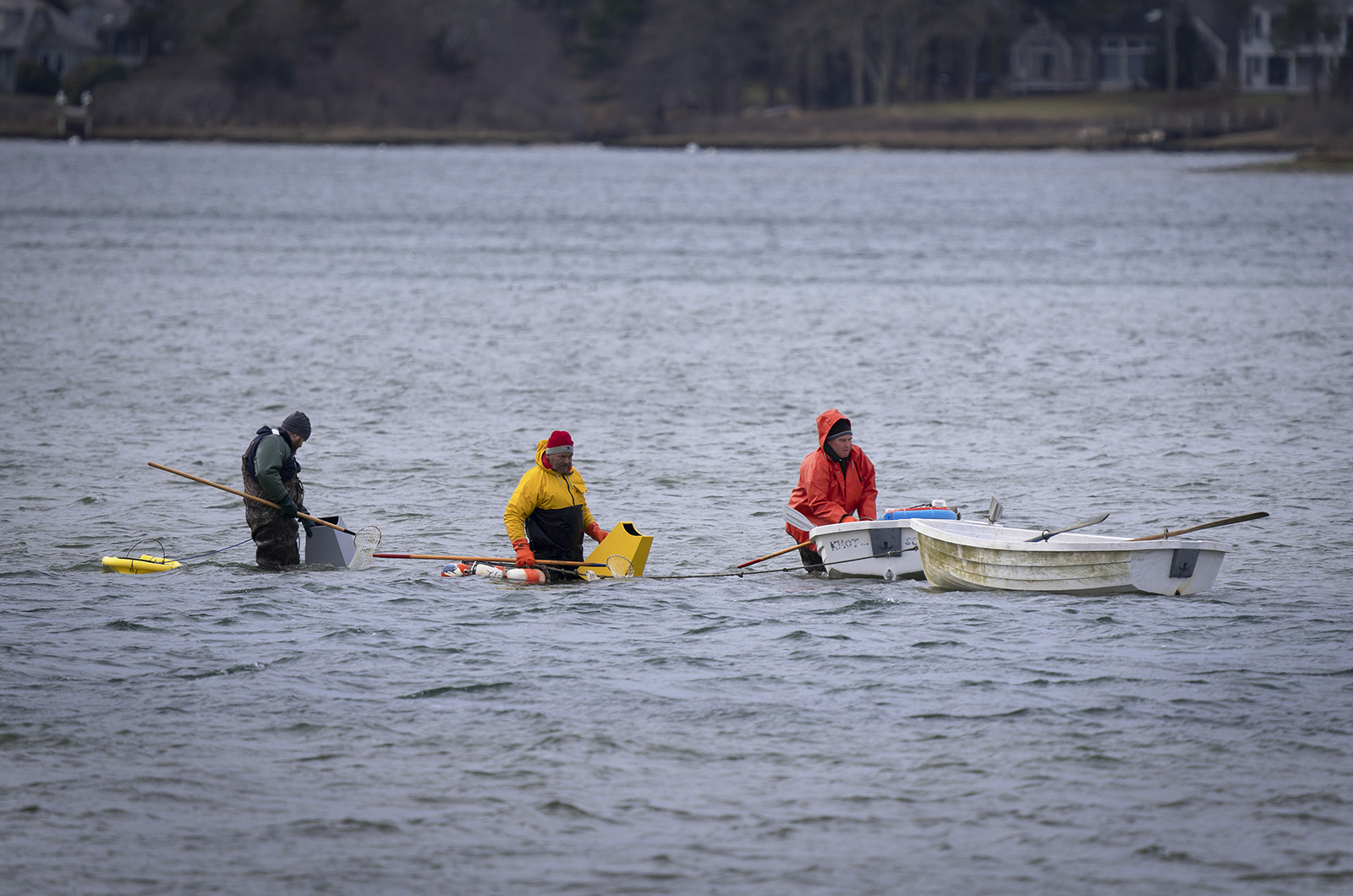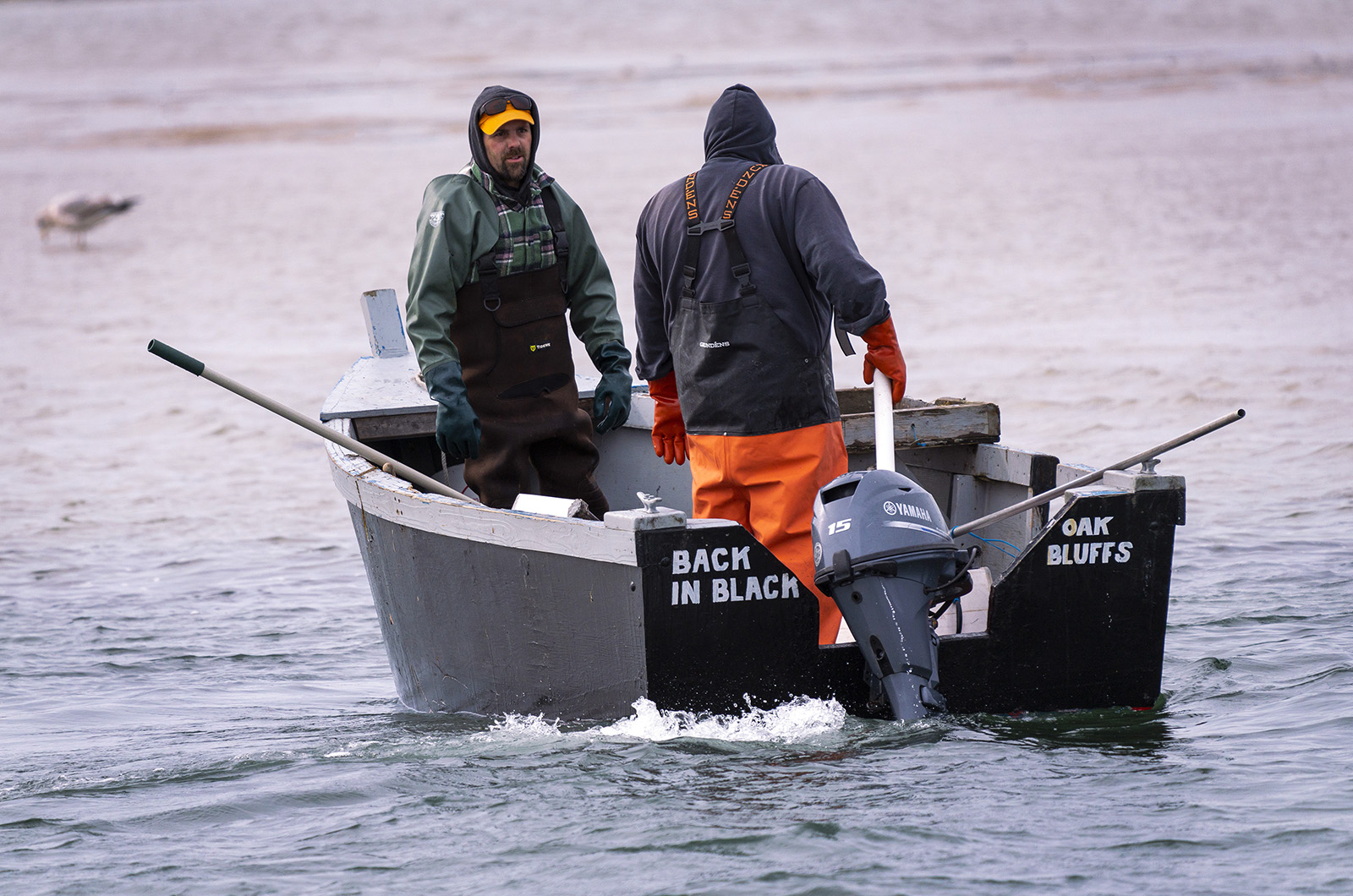It has been a bountiful season for the Vineyard’s bay scallop fishery, one of the last places left where fishermen are still able to pull in semi-consistent harvests.
But scallopers have struggled to take advantage of the strong season because the spike in supply stressed a distribution network atrophied from years of uncertainty.
“The market just closed down, three out of the four main buyers in Edgartown just totally shut down,” said Arno Ewing, who works on John Conlon’s Sengekontacket-based scalloping boat. “I don’t think I’ve seen prices this low in five years.”
The majority of bay scallops on-Island come from Edgartown, out of Sengekontacket or Cape Pogue, and are exported to the mainland. Martha’s Vineyard and Nantucket are the largest bay scallops producing communities in Massachusetts, and the catch can go for as high as $70 per pound in New York and Boston markets.
While earlier in the season scallopers could count on getting $27 per pound for their catch, fishermen on-Island are now only getting around $15. The situation was even more dire last month, when fishermen were hard-pressed to find any buyer at all, said Net Result fish market manager Mike Holtham, who sells scallops locally and to regional distributors.
“The demand just wasn’t there…it’s a shame because they are so beautiful this year,” he said. “They’re big and sweet as I’ve ever tasted.”
While it’s unclear why the demand for scallops couldn’t keep up, several factors appear to have contributed to the crash in the market, which reached its low point in early and mid-January.
Solid harvests for Nantucket and Cape Cod Bay, as well as stretches of good fishing weather, may have factored in pumping up the supply and lowering the demand. Orleans deputy shellfish constable Greg Normandy agreed that Cape Cod Bay had a better than usual scalloping season.
Tyler Gibson, co-owner of the Fish House and another scallop buyer, added that the general economic climate might have contributed to the demand glut.
“Bay scallops are very much a luxury item. When people aren’t eating out and not wanting to spend money, people don’t buy them,” Mr. Gibson said. “I ended up with 600 pounds that couldn’t get sold in Boston...I don’t know until basically the day I’m going off-Island if they are going to buy.”
The inability of regional distributors to match a superlative harvest might point to a more systemic issue in the scallop market, according to Edgartown shellfish constable Rob Morrison.
“When there were scallops everywhere, there were markets everywhere,” said Mr. Morrison, who noted that the roughly 8,000 bushels this year was the largest harvest since he started as deputy constable more than a decade ago.
Similarly, Mr. Holtham said restaurants would have scallops as a regular menu item across the East Coast when the eateries could count on daily scallop supplies each season. But when the Islands’ harvests became less consistent, and the Peconic Bay fishery off Long Island, New York all but collapsed, scallops were relegated to weekly or monthly specials.
Now, in a year when distributors might have been able to sell to restaurants on a more consistent basis, that demand has disappeared. To rebuild it, the scallop fishery would need to be able to pull in these larger harvests on a more consistent basis.
But with the number of unknowns that remain in the bay scallop fishery, such consistency seems unlikely.
Emma Green-Beach, executive director of the Martha’s Vineyard Shellfish Group, said this year’s harvest might not be indicative of any greater upward trend. The shellfish group supplies seed to each of the towns’ shellfish constables, as well as engaging in a series of initiatives meant to benefit the range of Island bivalves.
“For better or for worse, everything in nature comes in cycles,” she said.
Not everyone had a productive year. While Edgartown’s harvest was plentiful, Menemsha Pond was at a historic low. Chilmark shellfish constable Isaiah Scheffer estimated that only about 12 bushels had come in this season.
As longtime scalloper John Conlon notes, the inconsistency makes the fishery unattractive to new fishermen.
“There just aren’t too many people doing it anymore,” he said. “If it was easy, everyone would do it.”
Explanations abound as to why Edgartown was up this year, with Mrs. Green-Beach proposing low precipitation, green crab trapping initiatives and earlier seeding as potential contributing factors. Still, she cautioned that next year might not be as good.
Meanwhile, as prices slowly inch up from last month, the close-knit Island scalloping community continues to weather the storm.
“I’ve been doing this long enough that these guys are my friends...I rely on them and they rely on me,” said Mr. Holtham.
While Net Result was closed, he said, Mr. Gibson kept buying from Mr. Holtham’s fishermen and now that the Net Result is reopened, Mr. Holtham plans to do the same.
Mr. Gibson recommended that scallopers take a break from dragging for a few weeks, especially as more severe weather hits the Island.
“The scallops aren’t going anywhere, so take a couple of weeks off and go at it hard during Valentine’s day,” he said.
Click here to see a historical video of the Vineyard scallop fishery, circa 1970s.









Comments (7)
Comments
Comment policy »